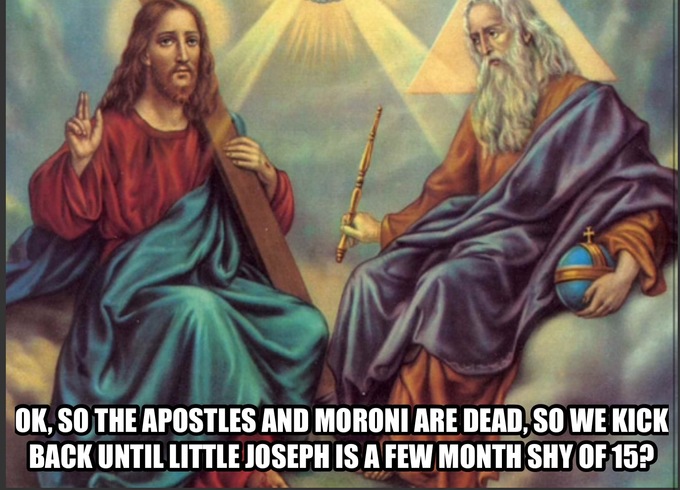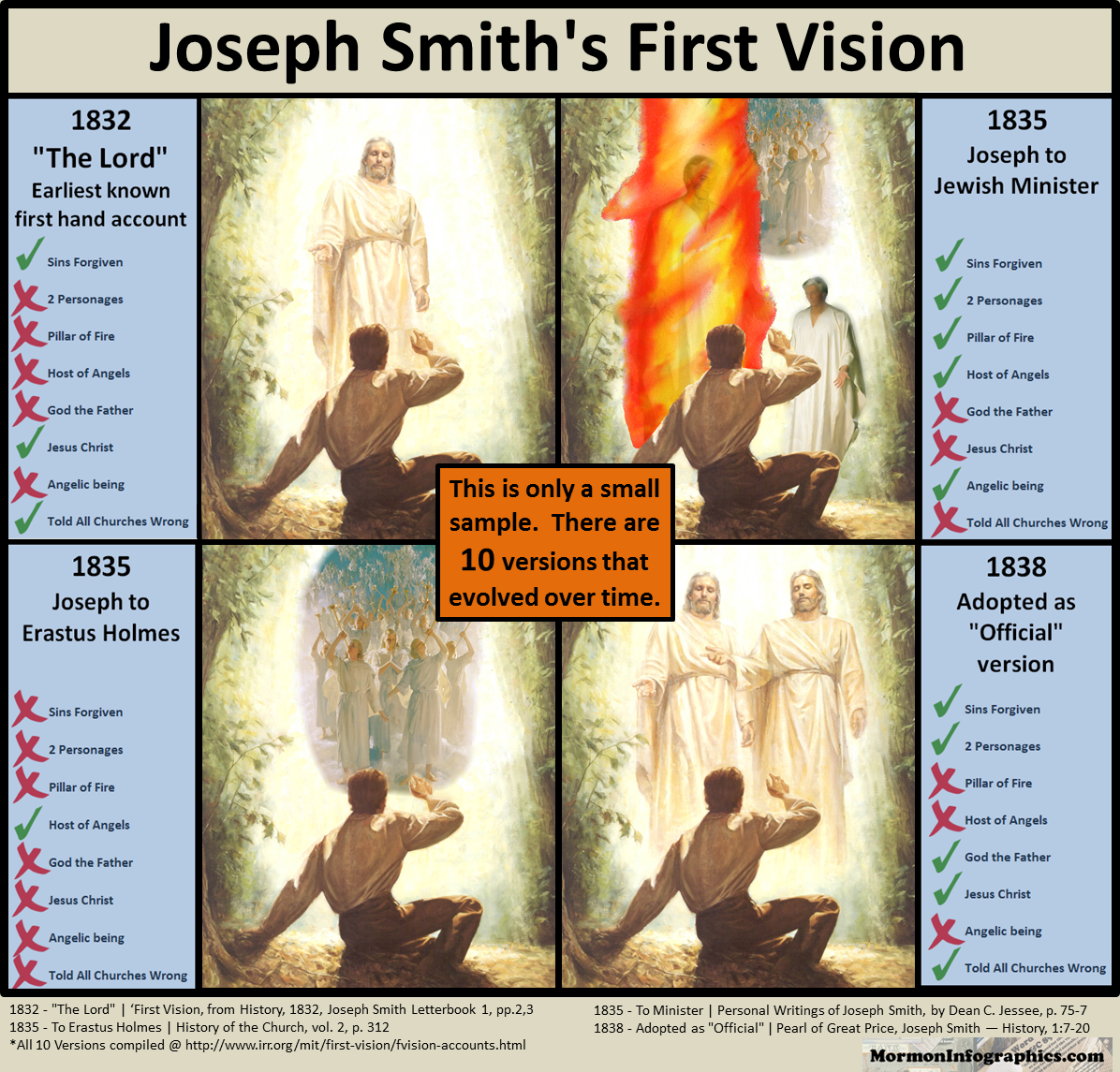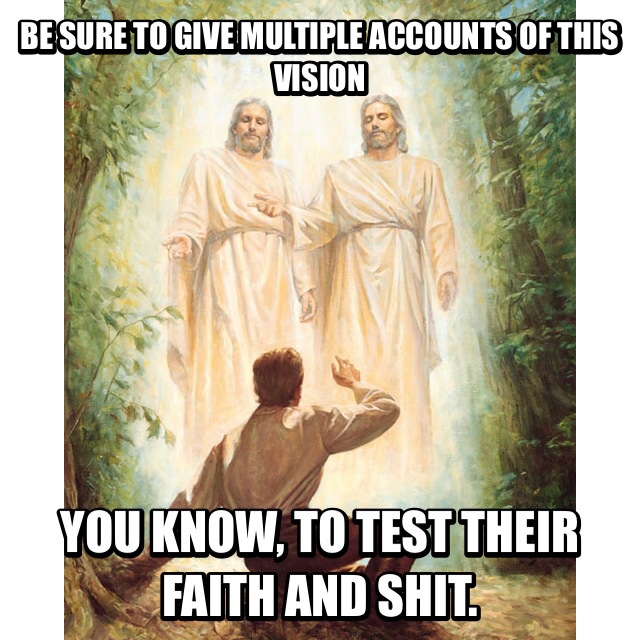“I Had Seen a Vision”
Reading assignment
Joseph Smith—History 1:1–26; Our Heritage, pages 1–4.
Links: Teacher’s manual | Student manual
It’s a busy year for Your Humble Godless Doctrine teacher. So I’m posting this lesson as kind of a rough outline, with the intention of filling in the details later. Think of this as the notes that a Gospel Doctrine teacher would walk into class with.
Overview
This one is about what’s become known as the First Vision, when Joseph Smith supposedly saw God and Jesus. The story is a relatively new thing in the church, but it has become an important part of its origin story.
Differing versions of the First Vision
For a long time, I was aware that there were multiple conflicting accounts of the First Vision. But I really didn’t understand why they were a problem. Doesn’t everyone tell the same story slightly differently through time? And doesn’t the way we tell a story depend to some extent on our audience?
Well, yes. But the differences in the “First Vision” accounts go deeper than just highlighting details. The circumstances around the story look less like a matter of emphasis and detail, and more like a bullshit story that has been made up.
Details
Yes, the details of the story differ across the tellings. Sometimes it’s an angel. Sometimes it’s many. Sometimes it’s Jesus. Sometimes it’s God and Jesus.
Change in canon
But wait — couldn’t it be all of the above?
That’s the problem. For years, the story of the First Vision that church leaders learned and taught explicitly excluded everyone except an angel. Like, they explicitly taught that God and Jesus did not visit Joseph Smith, and that there were good reasons for them not to show up. From MormonThink:
In 1854
“Some one may say, ‘If this work of the last days be true, why did not the Saviour come himself to communicate this intelligence to the world?’ Because to the angels was committed the power of reaping the earth, and it was committed to none else.” – Apostle Orson Hyde, General Conference Address, Journal of Discourses, Vol. 6, p.335
In 1855
The Lord did not come with the armies of heaven, in power and great glory, nor send His messengers panoplied with aught else than the truth of heaven, to communicate to the meek the lowly, the youth of humble origin, the sincere enquirer after the knowledge of God. But He did send His angel to this same obscure person, Joseph Smith Jun., who afterwards became a Prophet, Seer, and Revelator, and informed him that he should not join any of the religious sects of the day, for they were all wrong; that they were following the precepts of men instead of the Lord Jesus; that He had a work for him to perform, inasmuch as he should prove faithful before Him.” (Journal of Discourses 2:170-171)
In 1857
Church Apostle Heber C. Kimball, speaking Nov. 8th, 1857, was unaware of a vision where Smith saw God and Christ:
“Do you suppose that God in person called upon Joseph Smith, our Prophet? God called upon him; but God did not come himself and call, but he sent Peter to do it. Do you not see? He sent Peter and sent Moroni to Joseph, and told him that he had got the plates.” (Journal of Discourses, vol.6, p.29)
If the story had happened the way it’s taught today, why were church leaders telling it this way as late as the 1850s?
Comparatively late appearance
The answer is that when these church leaders were talking about heavenly beings appearing to Smith, they were talking about Moroni —

— sorry, Nephi — appearing to him. The story of the First Vision isn’t a thing that people started talking about until much much later. This didn’t become an important part of the church’s origin story until the 1880s.
In other words, the church had 50 years to get its story straight.
The more you look into this, the less it looks like simple differing accounts, and more like a cobbled-together story that didn’t happen.
Leg operation
From the manual:
3. Ask a class member to prepare to summarize the account of young Joseph Smith’s leg operation (Our Heritage, pages 1–2).
I always thought this story was bullshit. Joseph Smith gets a leg infection, and heroically (and inexplicably) refuses the trappings of frontier medicine.
The doctor brought cords to bind the boy, but Joseph objected, saying that he would bear the operation without them. He also refused brandy, the only form of anesthetic available to him, and asked only that his father hold him in his arms during the operation.
Why would young Joseph Smith refuse brandy? The Word of Wisdom wouldn’t have been out for another 20 years. Redditor Mithryn suspects that if this did happen, it was Joseph’s reaction to his alcoholic father.
The Apostasy
If there was an organised church in Jesus’ time, this would be God’s chance to get his plan going. But according to the LDS Church, he decided to drop it all and pick it up again later, leaving millions of people in the dark about his plan. This means that, if the Mormon religion is right, very few people in history will ever have been exposed to God’s teachings.

Is that a sensible way of doing things? Or is this a story invented after the fact, as an attempt to explain why Joseph Smith needed to start up a new religion?


Recent Comments